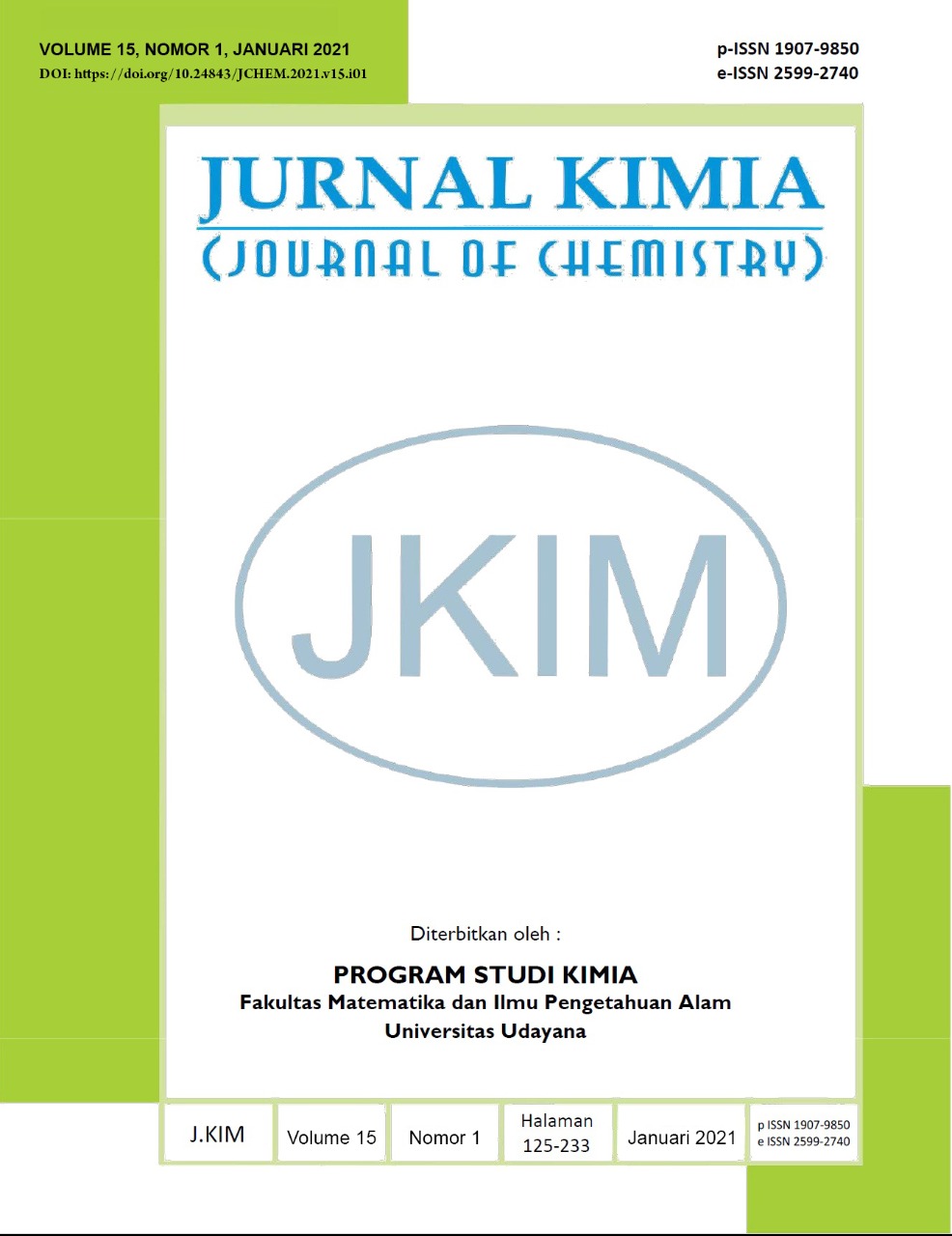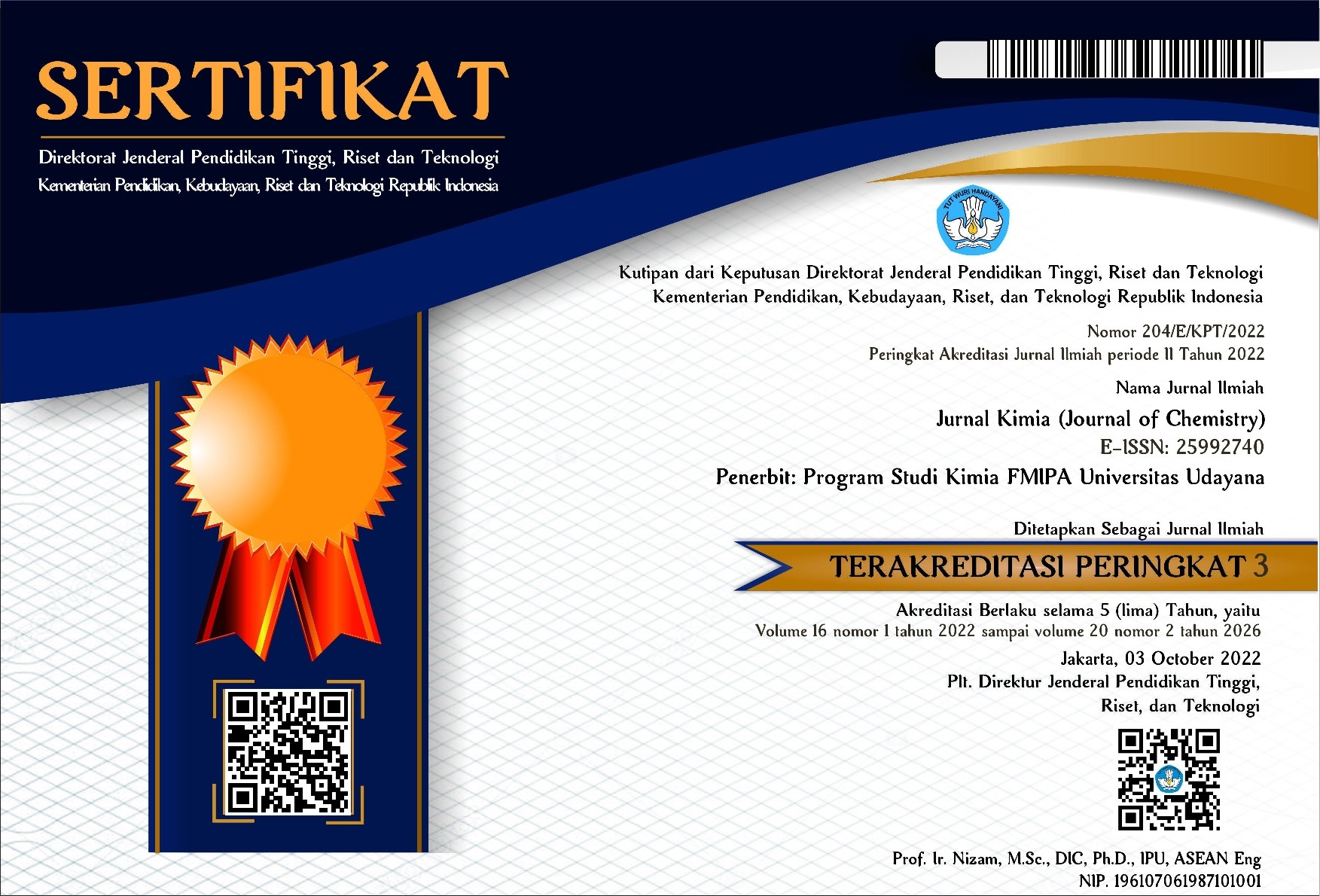BIOAVAILABILITAS DAN KANDUNGAN Pb, Cu PADA TANAH DAN SAWI PUTIH DI DESA BATURITI
Abstract
Faktor geologis dan cara pengolahan tanah pertanian serta penggunaan pupuk secara berlebih dalam proses pertanian berpengaruh pada kandungan logam berat dalam tanah, sehingga dapat menyebabkan tanah dan hasil pertaniannya tercemar oleh cemaran logam berat. Penelitian ini bertujuan untuk mengetahui tingkat pencemaran dan bioavailabilitas logam Pb dan Cu dalam tanah pertanian di Desa Baturiti serta menentukan kandungan logam berat tersebut dalam daunsawi putih hasil pertanian didaerah tersebut. Metode yang digunakan adalah metode ekstraksi bertahap dan pengukuran logamnya menggunakan Atomic Absorption Spectrophotometer (AAS). Kandungan Pb total pada tanah sebelum penanaman dan saat panen berturut-turut 132,4190–236,1381 mg/kg dan 185,2171–273,1228 mg/kg. Begitu juga kandungan Cu total berturut-turut 73,0249–100,3995 mg/kg dan 84,7515–101,0791 mg/kg. Bioavailabilitas logam Pb dan Cudalam tanah pertanian sebelum penanaman yang terdiri dari: serta merta bioavailable, berpotensi bioavailable dan non bioavailable berturut-turut 25,47-40,22%, 40,62-53,67% dan 19,16-21,80% untuk Pb,2,42-3,11%, 49,42-74,73% dan 22,85-48,13% untuk Cu. Kandungan Pb dan Cu total dalam daun sawi putih berturut-turut 29,3278-40,8476 mg/kg dan28,3933-36,2952 mg/kg atau setaradengan 60,54-66,15% dan 60,24-66,75% dari kandungan logam dalam seluruh bagian tanamannya. Dengan demikian, tanah pertanian di Desa Baturiti tergolong tidak tercemar logam Pb dan Cu menurut nilai the farmer Greater London Council serta logam beratnya dominan berpotensi bioavailable. Sementara itu, daunsawi putih tergolong tercemar logam Pb dan Cu karena melebihi ambang batas yang telah ditentukan oleh Badan Pengawas Obat dan Makanan.
Kata Kunci: bioavailabilitas, logam total, Pb dan Cu, sawi putih, tanah pertanian
Geological factors, the method of agricultural cultivation, as well as the excessive fertilizers uses can affect the content of heavy metals in the soil. High content of the metals in the soil can pollute the soil itself and also the agricultural products. This study aimed to determine the pollution level and the bioavailability of Pb and Cu in agricultural soil, as well as the metals content in the edible parts of chicory produced from the agricultural land in Baturiti Village-Bali. The method used was the sequential extraction followed by Atomic Absorption Spectrophotometry (AAS) measurement. The range of total Pb contents in the soil before planting and after harvesting were of 132.4190-236.1381 mg/kg and 185.2171-273.1228 mg kg, respectively, while the range of Cu contents before planting and after harvesting were of 73.0249-100.3995 mg/kg and 84.7515-101.0791 mg/kg, respectively. Bioavailabilities of Pb and Cu metals in agricultural soils before planting were as follows: readily bioavailable, potentially bioavailable and non bioavailable, were of 25.45-40.22%, 40.62-53.67% and 19.16-21, 80% for Pb, 2.42-3.11%, 49.42-74.73% and 22.85-48.13% for Cu, respectively. The species of metals were dominated by potentially bioavailable. The range of Pb and Cu contents in the edible parts of chicory were of 29.3278-40.8476 mg/kg and 28.3933-36.2952 mg/kg or 60.54-66.15% and 60.24-66.75% of the total metals in the whole vegetable plant, respectively.Therefore, the agricultural soil in Baturiti area could be classified as not being contaminated with both Pb and Cu according to the Greater London Council farmer values. Meanwhile, the edible parts of chicory contained Pb and Cu which were exceeded the maximum contents allowed by the Indonesia Food and Drug Supervisory Agency.
Keywords: agricultural soil, bioavailability, chicory, Pb and Cu
Downloads
References
Alloway, B.J., 1995, Heavy Metals in Soils, 2nd Ed. Glasgow, London: Blackie.
Angima, S., 2010, Toxic Heavy Metals in Farm Soil, Oregon State University, V(3):1-3.
Aryawan, R., 2017, Kandungan Logam Pb dan Cu Total dalam Air, Ikan dan Sedimen di Kawasan Pantai Serangan serta Bioavailabilitasnya, Jurnal kimia, 11 (1): 56-63.
Chae Hee Dong, Sun Young Choi, Eun Ji Cho, Yoo Mi Cho, Sa Ra Lee, Eun Sil Lee, Hyoung Moo Park., 2014, Awareness and Experience of Menopausal Symptom and Hormone Therapy in Korean Postmenopausal Women, Journal of Menopausal Medicine, 20 (7):13.
Codex Alimentarius Commission (FAO/WHO)., 2010, Food Additive and Contaminants, Joint FAO/WHO Food Standard Program, ALINORM 01/12A: 1-289.
Fytianos, K. and Lourantou, A., 2003, Chemical Speciation of Elements in Sediment Samples Collected at Lakes Volvi and Koronia, N. Greece, The 8th International Conference on Environmental Science and Technology Lemnos Island, Greece, 8-10 September: 208-215.
Ibe, I. J., Ogbulie, J. N., Orji, J. C., Nwanze, P. I., Ihejirika, C., Okechi, R. N., 2014, Effects of Palm Oil Mill Effluent (Pome) on Soil Bacteria and Enzymes at Different Seasons, International Journal of Current Microbiology and Applied Sciences, 3 (10): 928-934.
Jaya, S. E. G. I., Siaka, M. I., dan Diantariani, P. N., 2014, Total Logam Pb dan Cr dalam Tanah Pertanian dan Air Danau Beratan serta Bioavailabilitasnya dalam Tanah Pertanian di Daerah Bedugul, Journal Kimia 8 (1): 28-34.
Kandarwati, Fitri, N., 2016, Evaluasi Kesuburan Tanah Pertanian Tebu di Kabupaten Rembang Jawa Tengah, Balai Penelitian Tanaman Pemanis dan Serat, Malang, Jurnal Littri 22 (2): 53-62.
Lepp, N.W., 1981, Effec of Heavy Metal Pollution on Plant, Journal of Applications Science. 1:99-121.
Oluremi, O.I. Ayodele, O.E., Olabisi, B.M., Wasiu, M.O., 2013, Speciation of Heavy Metal in Soil, and Their Phytoavailability in Edible Part of Amarantus hybridus Cultivated Along Major Roads in Ile-Ife Nigeria, African Journal of Pure and Applied Chemistry, 7(5): 184-193
Reichman, S.M., 2002, The Responses of Plants to Metal Toxicity: A Review Focusing on Copper, Manganese, and Zinc, The Australis Mineral and Energy Environment Faundation, Australis
Siaka, I M., 2016, Spesiasi dan Bioavailabilitas Logam Berat dalam Tanah dan Akumulasinya dalam Sayuran sebagai Dasar Penentuan Tingkat Aman Konsumsi, Disertasi, Universitas Udayana. Denpasar.
Siaka, I M. Nurcahyani, H. Manuaba, P B I., 2019, Spesiasi dan Bioavailabilitas Pb dan Cu dalam Tanah Pertanian Organik di Bedugul serta Kandungan Logam Totalnya dalam Sayur Brokoli, Jurnal Kimia, 13(2): 145-152.
Tessier, A., Campbell, P. G.C., and Bisson, M., 1979, Sequential Extraction Procedure for the Speciation of Particulate Trace Metals, Analytical Chemistry, 51(7): 844-851.

This work is licensed under a Creative Commons Attribution 4.0 International License






